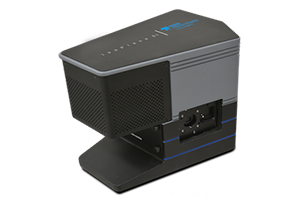Dr. Mark Waterland, Associate Professor
Institute of Fundamental Science, Massey University, New Zealand
Background
Dr. Mark Waterland’s research at Massey University in New Zealand is driven by an interest in the development and properties of new molecular and nanostructured materials for energy conversion, energy storage, and chemical sensing. His group has expertise in Raman spectroscopy, including resonance Raman spectroscopy, theory of Raman intensities, and surface- and plasmon-enhanced Raman.
The group applies Raman spectroscopy to complex analytical problems, collaborating with medical researchers, veterinarians, ecologists, plant biologists, engineers, and food scientists. They also work with statisticians and mathematicians to apply state-of-the-art data analysis to Raman datasets for the purpose of classification (e.g., skin cancers) or following chemical or physical changes to various materials.

Figure 1 shows the group’s specialized microscopy set up. With a 50 micron collection fiber connects to FERGIE (IsoPlane 81) via the spectrograph’s fiber port and Focusing CUBE. A spectrum of PMMA is visible on the monitor. This experimental set-up has been used to collect MoS2 nanoribbon spectra and graphene nanoribbon spectra.
Challenge
The group’s current research activities focus on the chemistry and spectroscopy of graphene nanoribbons. They use their expertise in Raman spectroscopy to analyze the edge structure of graphene nanoribbons produced by mechanical fracturing. Edge structure determines the physical properties and chemistry of the graphene nanoribbons. Controlling the functional groups at the nanoribbons provides a route to controlling the physical properties of nanoribbon suspensions and, ultimately, to controlling the self-assembly of nanoribbon structures.
Therefore, a reliable system that is quick and easy to set up is essential for graphene nanoribbon edge characterization.
“FERGIE (IsoPlane 81) yields research-quality results…but without the learning curve of our previous system. The FERGIE spectrograph makes it a snap to set up and acquire spectra.”
Solution
His group found that the IsoPlane 81’s ability to produce aberration-free data was extremely impressive, alongside its versatility. This made it simple to acquire research-quality results reliably.
As the IsoPlane 81 is compatible with ThorLabs products it made experimental procedure easy and effective. Utilizing the informative videos available from Princeton Instruments allowed his group to expand their experimental procedure to include fluorescence.
Not only was this a tool that aided his research group, it was also able to provide a genuine research experience for undergraduate students, allowing them to manage their own project with access to the latest research equipment.

